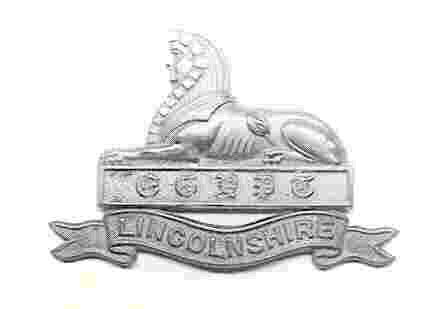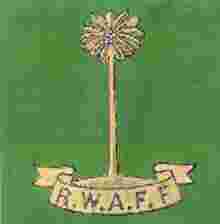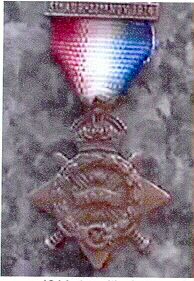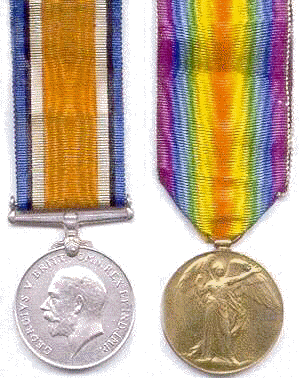



MARSHALL, Henry
Lieutenant Colonel
1st &2nd Battalions Lincolnshire Regiment,
Nigerian Regiment (Royal West African Field Force)
and the 18th Battalion Essex Home Guard
who died on Friday, 23rd May 1952. Aged 59

Henry was born 30th October 1892. He was a regular soldier serving from 1914 through both World Wars and a campaign in Palestine in the 1930’s. He was invalided out of the Army in 1946 but continued to serve his Country in the Home Guard. He lived on his farm at Manwood Tye in Abberton with his wife, Mrs. Dorothy Beatrice Marshall. He is buried at Saint Andrew’s Abberton in the South East corner and there is a small silver cross dedicated to this brave soldier, which is on the altar during services.

WORLD WAR 1
Henry was commissioned as a 2nd/Lt. on 10th June 1914. He was to serve throughout the war in France and Belgium with the 1st Battalion of the Lincolnshire Regiment. During that time, he was wounded three times.
Initially Henry was in France from 4th November 1914 till 10th January 1915. He returned for a second tour of duty on the 1st April 1915 till 7th July 1916. Initially they fought, as part of the 9th Brigade 3rd Division. He is shown in the Unit War Diary as rejoining the Battalion with 14 Other Ranks on the 14th April 1915. That night at 11pm while a working party of 150 men was engaged in construction of communication trenches, the enemy opened up with heavy rifle fire and artillery. Our artillery replied and after about an hour the heavy bombardment silenced the enemy guns. An enemy infantry attack was dispersed as soon as they appeared above the trenches.
In May, the Battalion moved to Bedford House on the 18th in support and were involved in typical trench warfare over the next few days, with several casualties from snipers, rifle grenades and occasional shelling. On the 24th "With the exception of a few rifle grenades fired by the enemy the day passed very quietly. D Company moved from the Canal Bank and relieved C Company in the fire trenches. B Company moved to Bedford House in support. Casualties Lieutenant H. Marshall slightly wounded Other ranks 4 wounded....." The Unit were relieved on the night of the 26th by the King's Own Scottish Borders and proceeded to billets in huts at Outerdom.
Henry rejoined the Battalion on the 25th June 1915, which appears to be in the line near Sanctuary Wood where their HQs were based since the 20th. " 25.6.1915 The day passed quietly. occasional shell bursting on our left. Carrier pigeons were introduced for signaling purposes. Officers joined Lieutenant H. Marshall....... A draft of 164 Other Ranks joined and remained with transport at Russeboom" . In all the Battalion spent 11 days in the line being relieved by their Territorial Battalions the 1/4th & !/5th. During this period Captain J. D. D. Wickham died of his wounds and 21 Other Ranks were wounded.
The 2nd September 1915 :- "At 7am preparations were commenced for moving to a new bivouac in...... The Battalion paraded at 10am and marched to new bivouac arriving about 1am. Heavy rain commenced to fall at 3 pm and continued almost incessantly throughout the day, causing great inconvenience to all ranks, but the adverse weather conditions were endured cheerfully by all ranks...... Captain H. Marshall assumed duties of Acting Adjutant, "A" Company were relieved by a Company of the 1st Battalion Northumberland Fusiliers and arrived at Battalion bivouac at 3am 3rd September Casualties 1 killed, 1 wounded."
During this tour, the 1st Lincolns were involved in the Battle of Loos from 25th September to 19th October 1915. This was the first battle where the British used chlorine gas to supplement the artillery barrage, due to a shortage of shells. The 1st Lincolns on the 25th September were involved in a subsidiary attack on Bellewaarde. Following this battle, the 1st Battalion Lincolnshire Regiment were reassigned to the 62nd Brigade 21st Division.
The 1st Lincolnshire Regiment were heavily involved in the Battle of the Somme, as part of 62nd Brigade 21st Division. On 1st July 1916, the 62nd Brigade were attacking just north of Fricourt. The War Diary reads as follows :- "The first day of the attack launched by the British in conjunction with the French at the Battle of the Somme. The 62nd Infantry Brigade being in reserve to the 21st Division, the Battalion was ordered to carry S. A. A. Mills Grenades and Stokes Mortar Bombs to a dump immediately North of the Eastern end of Patch Alley on the Sunken Road. At 9am billets at Meaulte were evacuated and the Battalion proceeded as detailed to a position at Bon Accord Street and Mareschall Street where loads were picked up. Battalion Headquarters was established in Aberdeen Avenue. At 1.30pm carrying parties proceeded across the open to the first line captured German trenches and thence to the Dump. Parties then returned to the first line captured position and work of consolidation begun in the sector X.20d.7.2 on the left to X.26.d7.8 on the right. Owing to the terrific effect of our artillery fire during the bombardment of this position the task proved a very arduous one and was rendered more difficult owing to the fact that the Battalion was subjected to heavy machine gun and artillery fire.
During the work of consolidation Battalion Headquarters was moved to the captured front line at X.26.d.7.9. At 6pm we were ordered to reinforce the 64th Brigade and proceeded as follows - B Company to Crucifix Trench with D Company and the Bermuda Volunteer Rifle Corps on their right, A&C Companies in support at Sunken Road, the latter Company joining up with the 34th Division on our left. Battalion Headquarters was established on the Sunken Road at the Dingle. The position taken over did not appear to have been consolidated at all, thus necessitating working continuously until 3 am on the morning of the 3rd July. The weather was fine and the night quiet. The total strength of the Battalion, including employ with transport on the morning of 1st July stood as follows Officers 40 Other Ranks 994 The following casualties were sustained..." There follows a list of 9 Officers wounded including Captain H. Marshall plus 3 Other Ranks killed, 105 wounded and 2 missing - a total of all ranks 119.
On Monday, the 3rd July, the 1st Lincolns sustained heavy losses from machine gun fire before reaching Shelter and Birch Tree Woods. At 2pm a German counter attack was beaten off and they took 800 prisoners.
Just prior to the Battle of the Somme, Henry, on the 15th June 1916, was "Mentioned in Dispatches".
He then had a break in the UK, returning to Flanders 19th January 1917 till 29th April 1917. During this time, he served with the 2nd Battalion with a third wounding on the 21st April. The 2nd Battalion were in the 25th Brigade, 8th Division. The German's were being pushed back to the Hindenburg Line between 14th March and the 5th April 1917. The following are excerpts from the War Diary:- "4.4.1917 : 1.00 pm ; Fins: The Battalion assembled in valley N. E. of Fins in support to attack by 2/Royal Berkshires and 2nd Rifle Brigade on Gouzeaucourt Wood and high ground S. of Wood zero hour was 2.00 pm. At about 3.00 pm C Company under Captain Clifton moved up to closer support to 2nd Royal Berkshires in S. E. corner of Dessart Wood and at 4.45 pm B Company under Captain Marshall was sent to report to Officer Commanding 2nd Royal Berkshires to maintain touch with them and the 20th Division on their left. This was done. At about 5.00 pm the remainder of the Battalion moved to valley N. E. of Heudecourt in support to 2nd Rifle Brigade on arrival D Company was used to maintain touch between the 2nd Royal Berkshire and 2nd Rifle Brigade. Eventually the objectives were gained and the Battalion moved back to Fins. B & D companies being relieved by the 2nd Royal Berkshires and 2nd Rifle Brigade respectively ( 2 killed 5 wounded).
He is next mentioned in an attack on the 21st April 1917 :-"21.4.1917: 4.20 am The battalion attacked Gonnelieu at dawn - At about 2.30 am C Company who knew the ground best were ordered to lay out the tape to assemble on. This was most efficiently done by 2/Lieutenant Middleton and was covered by patrols under 2/Lieutenant Howard. At 3.20 am the Battalion was in position preparatory to the assault as follows - Assaulting Companies, B Company Captain Marshall on the right D Company Captain Bruce on the left. Front line on tape extended to 5 paces, 2nd line 50 paces in rear. A Company 2/lieutenant Mann and C Company Captain Clifton, in support in outpost line. At 4.20 am the barrage commenced and 2 companies assaulted (a) No difficulty was experienced in getting through the wire except on the extreme right, that platoon finding the wire strong and uncut and being heavily fired on endeavouring to get through their officer Lieutenant Davies having ascertained the left of the company had got through ordered his platoon to reform 50 yards back and get in more to the left, which was well carried out. In the meantime Captain Clifton C Company in support seeing the difficulty this platoon was experiencing sent up a platoon of his company to go through the gap more to the left and capture the South portion of the village opposite where the platoon had been temporarily held up. The barrage which was followed very closely, a few casualties being suffered by doing so and the first objective was captured at 5.00 am (b) D Company was by this time along the centre of the village facing North and captured the Northern half of the village and sent up 4 Very Lights as arranged as a signal he had done so at 5.15 am. there was quite heavy fighting in the village isolated groups of the enemy holding out in houses and coming up from dugouts but these parties were attacked and killed or captured with great dash. the left of this northern advance went through the Chateau. No enemy were seen in the trench west of it until later when the company was consolidating North of the village and the Rifle Brigade were fired on from this trench when advancing. The left post N. E. of the Chateau fired on these men and killed some and 2 Stokes mortars and a party had been collected to deal with them when the Rifle Brigade came up and captured them (c) A heavy enemy's barrage started West of the village at 4.40 am and this was switched on to the village later about 5.10 am mostly 77 mm guns and heavy machine gun and rifle fire from the enemy's defences in ravine and South of the village, which was replied to by the Support companies with rifle and Lewis Gun fire. (d) By 5.20 am both assaulting companies were digging in on their final objectives North and East of the village. (e) At 5.00 am the Southern portion of the village being captured A & C Companies with half their companies each (C on the left A on the right) in front line pushed forward on the right and south of the village and continued the line of D & B companies on their objectives southwards. A Company were held up doing this by a crater for a few minutes but charged it and captured some prisoners. A & C Companies were not able to advance as far as their final objective until later in the day as the Brigade on our right had not come up and heavy Machine Gun fire was being directed down the ravine at them (f) D Company on the left of the Battalion was relieved by the Rifle Brigade by 6.00 pm and dug themselves in in Battalion support South West of village (g) All Companies were shelled whilst they were consolidating. About 48 prisoners were taken in this attack 4 Machine Guns and 4 Trench Mortars. Captain Marshall and 2/Lieutenant Bloomer wounded. Other Ranks 11 killed 29 wounded 1 missing. the Battalion was relieved by the 2nd Royal Berkshires and proceeded back to Brigade Reserve in Heudecourt billets."
Finally, after a year's break he returned 24th April 1918 till 27th May 1918.
Henry was acting Temporary Lieutenant from 15th November 1914 till 10th January 1915. On the 11th January 1915 he was promoted Lieutenant and was Acting Captain between 26th June 1915 and 22nd December 1917. He was confirmed in the rank of Captain on the 23rd December 1917.


He was awarded the 1914 Star with clasp for Mons, the British War Medal and the Victory Medal. The British War Medal would have had an oak leaf representing the Mention in Dispatches
BETWEEN THE WARS
He was Adjutant to a TA unit from 1st April 1923 until the 30th September 1926.
He reverted to the 1st Battalion and served as Adjutant from 5th September 1928 till 4th September 1931(#)
At this point he moved to the 2nd Battalion (*) He saw Service in Malta, Gibraltar, Hong Kong and Malaya in the following years plus was on Active Service in Palestine between 1936 and 1939, where he was Mentioned in Dispatches on the 23rd July 1937. He is shown as c/o "A" Company in reports dated 14th July 1936 and 2nd in Command of the Battalion 22nd June 1938. He received the General Service Campaign Medal and clasp for Palestine.

This medal would have had an oak leaf representing the Mention in Dispatches
He was promoted to Major on the 28th October 1934 and to Lieutenant Colonel on the 31st August 1938, when he took over command of an Infantry Battalion of the Nigerian Regiment.
WORLD WAR 2
Henry was with the Nigerian Regiment, who were part of the Royal West African Field Force, during the Abyssinian campaign.
The British sent an invasion force from Kenya to liberate Abyssinia. Included were two African Divisions with Nigerian regiment infantry battalions, one of these was commanded by Henry Marshall. After some 100 miles drive over rough ground the Ghanaians, in the Royal West African Field Force, met opposition at Juba from Italian forces, which were native troops with Italian officers. This was 4th February 1941. They pursued the Italians for some 800 miles. They were joined by the 23rd Nigerian Brigade, in time to run into Italian infantry at Marda Pass. The action here lasted for the 22nd and 23rd February before the Nigerians fought their way through. On the 24th February there was another fierce fight at Babile Pass. 26th and 27th February were occupied in the Nigerians fighting their way across the Bisidimo River. After this action the units fanned out and the Nigerians had further major actions at Abalti, Demli and Gimbi. 94 days after the campaign started it was over, with the surrender of the Duke of Aosta on the 20th May. This was the first major successful campaign of the war by British troops. The Nigerian troops were withdrawn in the July having performed exceptionally well. At this time, Henry returned home to spend over a year as training officer of a Home guard sector at Bradford.




Defence Medal !939-45 War Medal Africa Star 1939-45 Star
POST WAR
Henry was with the Allied Military Government in Germany immediately post-war. However, his health was deteriorating and he was invalided out in 1946. He retired to farm fruit at Abberton.
In December 1951, Henry was appointed to command the 18th Battalion of the Essex Home Guard, which included the Peldon, Layer, Birch & Tiptree areas as well as Abberton & Langenhoe.
references:-
We are indebted to the staff of Lincolnshire County Council's "Museum of Lincolnshire Life" for researching the War Diaries
(#) These dates are from the Army List (*) are from the 2nd Battalion Diary
Details of Henry's career are taken from the Army List & an article from the May 30th 1952 edition of the Essex County Standard
"The Somme" by Chris McCarthy was the source of details on the 1st Lincolns at the Somme.
Details of the Nigerians in Abyssinia are drawn from "World War 2- Nation by Nation" by J. Lee Ready
10/30/02 date last updated
**********************************************************
These pages are dedicated to the memory of the Fallen from the two World Wars, who lived in Abberton & Langenhoe.. Prepared by Saint Andrew's Parochial Church Council. November 11th 2000